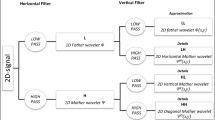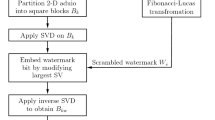Abstract
International Federation of Phonographic Industry (IFPI) has laid requirements for digital audio watermarking (DAW) schemes with regard to robustness, imperceptibility and payload. In addition, DAW schemes have to offer audio integrity. Many of the schemes fails to provide both copyright protection and tamper detection. Moreover, tamper detection of audio is not evaluated in quantitative manner. Therefore, a robust and blind DAW scheme has been developed in transform domain to suffice this requirement. Further, an objective performance metric, detection accuracy, is proposed to quantify the performance of tamper detection. In the proposed work, audio is fragmented and transform coefficients are obtained using Wavelet and Cosine Transforms. Watermark image is pre-processed using logistic map and BCH code. This pre-processed image is inserted into singular values of audio signal coefficients through quantization index modulation. Hash is generated with SHA-512 algorithm and is inserted in watermarked audio frames. Hash recovery at the receiver allows to identify any tampering involved in audio viz., deletion, copy-move and substitute attacks. Singular vectors are not required to extract the watermark, thus this method is free from false positive problem and can provide copyright protection. Experimentation is carried out on five different classes of audios which substantiates that robustness, imperceptibility and payload results are acquiescent to IFPI standard. Further, comparative analysis indicates that developed scheme is better when compared with other state-of art-schemes. Consequently, this DAW scheme helps in forensic examination of audio recording for authentication purpose.








Similar content being viewed by others
References
Ahmad M, Al Solami E, Wang XY, Doja MN, Sufyan Beg MM, Alzaidi AA (2018) Cryptanalysis of an image encryption algorithm based on combined chaos for a BAN system, and improved scheme using SHA-512 and hyperchaos. Symmetry 10(7):1–18
Al-Haj A (2014) A dual transform audio watermarking algorithm. Multimed Tools Appl 73(3):1897–1912
Chen X, Yuan W, Wang S, Wang C, Wang L (2019) Speech Watermarking for Tampering Detection Based on Modifications to LSFs. Mathematical Problems in Engineering 1–10
Cichowski J, Czyżewski A, Kostek B (2015) Analysis of impact of audio modifications on the robustness of watermark for non-blind architecture. Multimed Tools Appl 74(12):4415–4435
Erçelebi E, Batakçı L (2009) Audio watermarking scheme based on embedding strategy in low frequency components with a binary image. Digit Signal Process 19(2):265–277
Guo J, Riyono D, Prasetyo H (2019) Hyperchaos permutation on false-positive-free SVD-based image watermarking. Multimed Tools Appl 78:29229–29270
Hu H, Chang J (2017) Efficient and robust frame-synchronized blind audio watermarking by featuring multilevel DWT and DCT. Clust Comput 20(1):805–816
Hu HT, Hsu LY (2015) Robust, transparent and high-capacity audio watermarking in DCT domain. Signal Process 109:226–235
Hu HT, Hsu LY (2016) A DWT-based rational dither modulation scheme for effective blind audio watermarking. Circuits Syst Signal Process 35(2):553–572
Hu HT, Hsu LY, Chou HH (2014) Variable-dimensional vector modulation for perceptual-based DWT blind audio watermarking with adjustable payload capacity. Digit Signal Process 31:115–123
Hu HT, Lee TT (2019) Hybrid blind audio watermarking for proprietary protection, tamper proofing, and self-recovery. IEEE Access 7:180395–180408
Hu HT, Lin SJ, Hsu LY (2017) Effective blind speech watermarking via adaptive mean modulation and package synchronization in DWT domain. Eurasip J Audio Speech Music Process 1:1–14
Jo D, Kwon S, Shin DJ (2018) Blind reconstruction of BCH codes based on consecutive roots of generator polynomials. IEEE Commun Lett 22(5):894–897
Karajeh H, Maqableh M (2019) An imperceptible, robust, and high payload capacity audio watermarking scheme based on the DCT transformation and Schur decomposition. Analog Integr Circuits Signal Process 99:571–583
Kaur A, Dutta MK (2018) An optimized high payload audio watermarking algorithm based on LU-factorization. Multimed Syst 24(3):341–353
Kaur A, Dutta MK (2018) High embedding capacity and robust audio watermarking for secure transmission using tamper detection. ETRI J40(1):133–145
Lalitha NV, Rao CS, JayaSree PVY (2016) Robust audio watermarking scheme with synchronization code and QIM. Int J Eng Technol 8(1):486–500
Lalitha N, Rao S, JayaSree P (2013) DWT — Arnold Transform based audio watermarking. 2013 IEEE Asia Pacific Conference on Postgraduate Research in Microelectronics and Electronics (PrimeAsia), pp 196–199
Lei B, Yann Soon I, Zhou F, Li Z, Lei H (2012) A robust audio watermarking scheme based on lifting wavelet transform and singular value decomposition. Signal Process 92(9):1985–2001
Lie WN, Chang LC (2006) Robust and high-quality time-domain audio watermarking based on low-frequency amplitude modification. IEEE Trans Multimed 8(1):46–59
Makbol NM, Khoo BE, Rassem TH (2018) Security analyses of false positive problem for the SVD-based hybrid digital image watermarking techniques in the wavelet transform domain. Multimed Tools Appl 77:26845–26879
Meenakshi K, Swaraja K, Kora P (2020) A hybrid matrix factorization technique to free the watermarking scheme from false positive and negative problems. Multimed Tools Appl 79:29865–29900
Mehallegue N, Loukhaoukha K, Zebbiche K, Refaey A, Djellab M (2020) Ambiguity attacks on SVD audio watermarking approach using chaotic encrypted images. Multimed Tools Applic 79(3–4):2031–2045
Homburg, H, Mierswa I, Moller B, Morik K, Wurst M (2005) A Benchmark Dataset for Audio Classification and Clustering In: Reiss JD, Wiggins GA (eds) Proc. of the International Symposium on Music Information Retrieval 2005, London, UK, Queen Mary University, pp 528–531
Pourhashemi SM, Mosleh M, Erfani Y (2019) Audio watermarking based on synergy between Lucas regular sequence and Fast Fourier Transform. Multimed Tools Appl 78(16):22883–22908
Shi C, Li X, Wang H (2020) A novel integrity authentication algorithm based on perceptual speech hash and learned dictionaries. IEEE Access 8:22249–22265
Wang X, Wang P, Zhang P, Xu S, Yang H (2014) A blind audio watermarking algorithm by logarithmic quantization index modulation. Multimed Tools Applic 71(3):1157–1177
Wu Q, Wu M (2018) A novel robust audio watermarking algorithm by modifying the average amplitude in transform domain. Appl Sci 8(723):1–17
Xiang S, Yang L, Wang Y (2017) Robust and reversible audio watermarking by modifying statistical features in time domain. Advances in Multimedia, Article ID 8492672:1–10
Zhu S, Zhu C, Wang W (2018) A new image encryption algorithm based on chaos and secure hash SHA-256. Entropy 20(9):716
Funding
This research did not receive any specific grant from funding agencies in the public, commercial, or not-for-profit sectors.
Author information
Authors and Affiliations
Corresponding author
Additional information
Publisher's Note
Springer Nature remains neutral with regard to jurisdictional claims in published maps and institutional affiliations.
Rights and permissions
About this article
Cite this article
Narla, V.L., Gulivindala, S., Chanamallu, S.R. et al. BCH encoded robust and blind audio watermarking with tamper detection using hash. Multimed Tools Appl 80, 32925–32945 (2021). https://doi.org/10.1007/s11042-021-11370-5
Received:
Revised:
Accepted:
Published:
Issue Date:
DOI: https://doi.org/10.1007/s11042-021-11370-5




